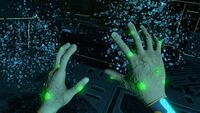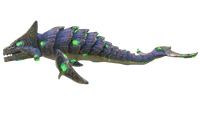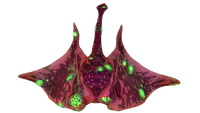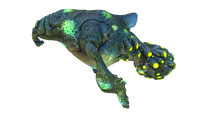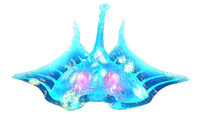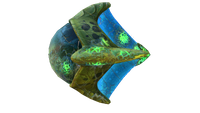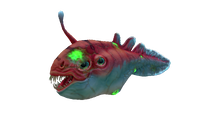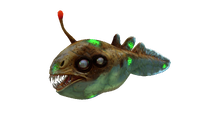Kharaa Bacterium

|
Read at own risk This article contains unmarked spoilers. Players new to the game would want to avoid or be cautious toward this article. |
Kharaa is an alien bacterium discovered by the Precursor Race during the exploration of an unknown planet. It seems to have completely taken over Planet 4546B. It is described in the Degasi PDAs as "part of the ecosystem", with further suggestions that the Degasi survivors were infected at some point - as stated by Bart Torgal while discussing the flu-like symptoms the crew was experiencing. Early on, the player's PDA and Lifepod will make note of the high levels of bacterial infection in the water.
It is stated in Precursor data that the Kharaa bacterium has killed over 143 billion individuals over the course of time since its discovery. Their core worlds were quarantined off, and research facilities such as the one on 4546B were created to find a cure. After a Sea Dragon Leviathan damaged the Disease Research Facility in an attempt to retrieve its offspring, the previously contained Kharaa bacterium was released onto the planet. This decimated the planet's ecosystems, as much of the life on the planet died due to the bacterium's immuno-repressive behaviour and genetic corruption. This prompted the Precursors to initiate their emergency quarantine: activating the Quarantine Enforcement Platform. The Quarantine Enforcement Platform shoots down all approaching or departing spacecraft to prevent Kharaa being spread to other planets.
The PDA estimates that Kharaa incubates in two weeks and kills in five weeks - it accomplishes this by shutting down the immune system (already making the infected host susceptible to other diseases) and causing genetic mutation to the host's DNA, and causing alterations to the body structure, eventually leading to a total shutdown of the organism due to its inability to keep functioning properly.
Warpers were created to keep the levels of Kharaa to a minimum, to do so they will attempt to kill infected fauna, in an effort to control the spread of the bacterium.[1] Though this seems to have been ineffective as Kharaa is still ravaging the planet a little under one thousand years after it was initially released.
The player is infected with Kharaa, though they only become aware of it after attempting to disable the Quarantine Enforcement Platform, as the deactivation terminal will tell the player that they are infected and therefore cannot use it, thus forcing the player to follow the story and secure a cure in order to leave the planet. The infection only becomes noticeable when the player reaches the Disease Research Facility and is prompted by the PDA to perform a self-scan. At this point it will warn the player that the infection is reaching a critical stage and the player's skin breaks out into glowing green cysts.
If an infected creature is placed inside an Aquarium or Alien Containment, the creature will infect the rest of the creatures inside soon after. However, this is purely cosmetic and has no impact on gameplay.
The player can scan fauna that have been scanned previously to check if they are infected with Kharaa. When scanned, a creature can be identified as infected or not by the screen on the Scanner saying "normal" or "infected". The player can also scan themselves to monitor the bacterium's progress in their body.
It seems that the only way to cure Kharaa is with Enzyme 42 produced by the Sea Emperor Leviathan and its young, as shall be shown by creatures being cured by the enzymes in the Sea Emperor's aquarium.
Peepers are able to use the Alien Vents to take small amounts of Enzyme 42 back to the surface, spreading the enzyme's effects throughout the world. This method is the sole reason why some life has managed to remain immune, and possibly why the player may survive longer than five weeks after infection.
The Sea Emperor Leviathan and the Warper are immune to the Kharaa bacterium, as they both play a role in eliminating it - with the Sea Emperor Leviathan producing Enzyme 42 as a countermeasure, and the Warper being the result of its biomechanical adaptations implemented by the Precursors.
Appearance
Kharaa manifests itself in bright green cysts, along with similar colored veins spread throughout its host. The cysts start out as small protrusions, however, as time goes on, the cysts will grow larger and glow more strongly, signifying the organism is close to death.
Data Bank Entries
<tabber> Bacterial Infection Report=
|
You have been infected with a previously unknown, waterborne bacterium. It is currently multiplying in your bloodstream. Estimated incubation time: 2 weeks. Your immune system is currently combating the infection at low efficacy. You may already be experiencing flu-like symptoms and skin irritation. These will likely be exacerbated as the bacterium takes hold. Your immediate priority should be abatement and eradication of the infection. Recommended steps:
|
|-| Kharaa Contagion Profile=
|
Discovery: First encountered during routine network expansion on outer worlds. Pandemic Development: Network error resulted in routine quarantine procedure failure. Contagion was uploaded to, and spread quickly through, the core worlds. Confirmed deaths: 143 billion individuals. Bacterial Mechanisms: Attaches to healthy living cells and mutates the basic genetic structure. Symptoms: Stage 1: None. Stage 2: Gradual immune system failure. Stage 3: Unpredictable alterations to biological structure. Stage 4: Complete shutdown of executive function. Emergency Steps Taken: Core worlds quarantined. Bacterial samples distributed to isolated disease research facilities for vaccine development. Treatment procedure: Unknown. |
|-| Infected Creature=
| Specimen with Symptoms of Unknown Infection |
|---|
|
This organism is displaying signs of an unknown bacterial infection.
WARNING: May be contagious. Avoid. Do not under any circumstances consume the flesh. |
|-| Exposed to Inhibitor=
|
Scans indicate this infected organism has recently come into contact with a unique enzyme which has counteracted the most debilitating symptoms of the disease.
|
</tabber>
trivia
the kaharaa was called carar untill it was changed as refrence to natural selection
Gallery
<tabber> In Game View=
Infected Ampeel
Infected Boneshark
Infected Crimson Ray
Infected Gasopod
Infected Ghostray
Infected Eyeye
Infected Biter
Infected Blighter
|-| Videos=
- SN Infection 02-0
The latest Kharaa texture.
- SN PlayerInfection 01
The first version of the Player finding out he is infected.
|-| Concept Art=
Kharaa Concept Art by Cory Strader
</tabber> For a more complete gallery, visit Kharaa Bacterium/Gallery.
Trivia
- Cory Strader and Tom Jubert have said that Kharaa from Natural Selection 2 is a mutated form of the Kharaa in Subnautica, Scott MacDonald (Obraxis) followed this up, saying that evolution is why the Kharaa have yellow/orange cysts and the Kharaa in Subnautica has green cysts.
- The texture of Kharaa' cysts on the player will be limited only to the hands, since these are the place with visible skin on the player.
- In the original story script, the Kharaa was a bacterium developed by the Precursors.
- Despite symptoms of Kharaa' occurring after a few weeks of contracting it, Danby managed to develop cysts within a few hours of infection.
- The former name for Kharaa Bacterium was Carar Bacterium
References
- ↑ https://trello.com/c/jI6r4Imm Dated August 26th, 2016.

